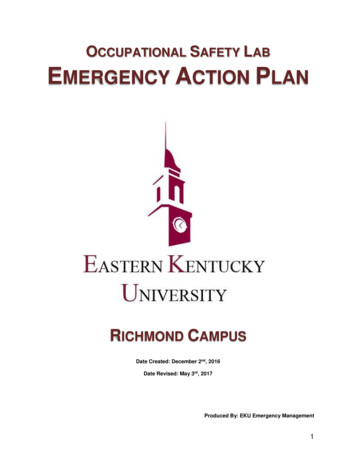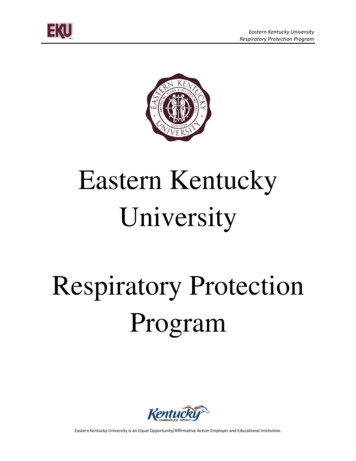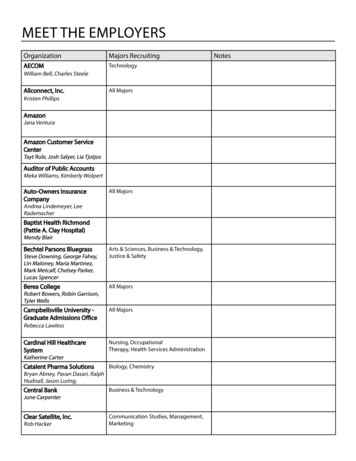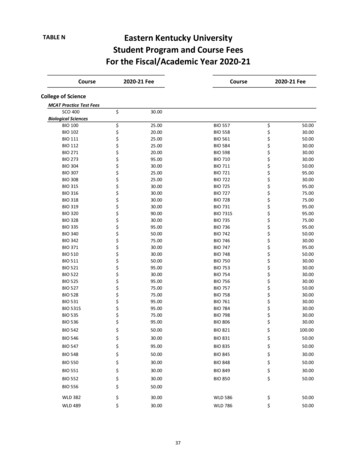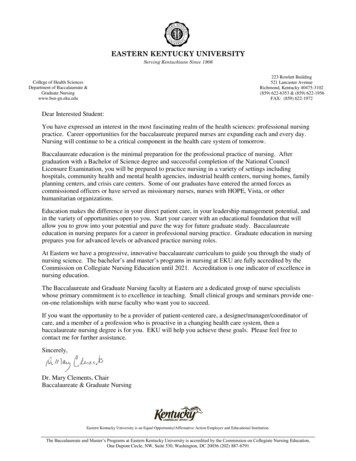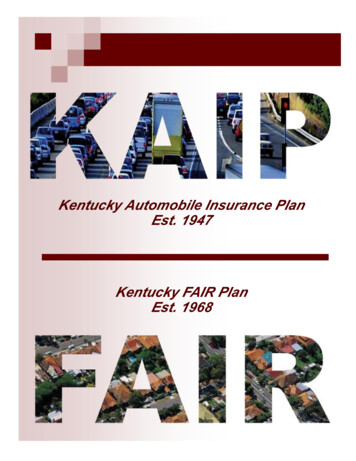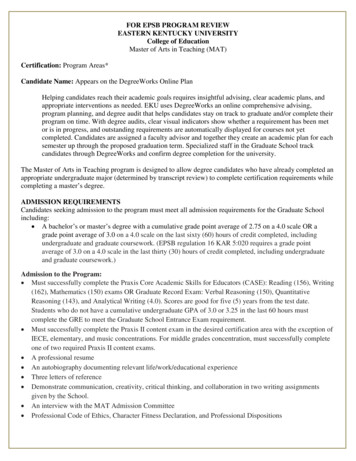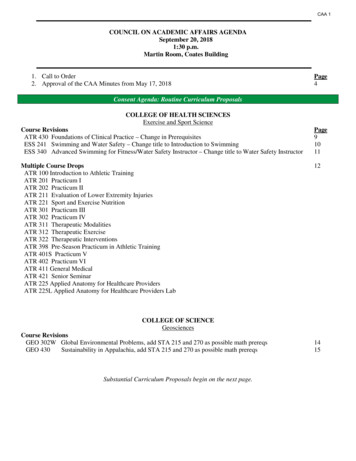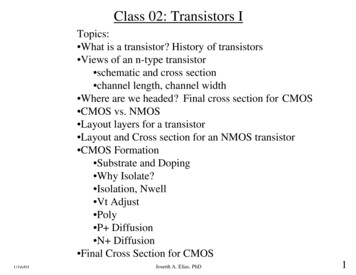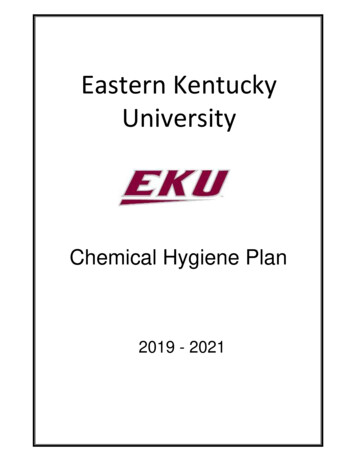
Transcription
Eastern KentuckyUniversityChemical Hygiene Plan2019 - 2021
TABLE OF CONTENTSPAGETABLE OF Y AND ASSISTANCE3IV.RESPONSIBILITIES AND AUTHORITY3V.STANDARD OPERATING PROCEDURES5VI.PROVISIONS FOR PARTICULARLY HAZARDOUS SUBSTANCES17VII.PRIOR APPROVAL18VIII.STANDARD LABORATORY EQUIPMENT19IX.CONTROLLING CHEMICAL EXPOSURES21X.EMERGENCY / MEDICAL PRACTICES22XI.EMPLOYEE INFORMATION AND S29APPENDIX 1: DETAILED DEFINITIONS30APPENDIX 2: CHEMICAL SAFETY PERSONNEL LISTING33APPENDIX 3: LABEL ELEMENTS35APPENDIX 4: SAFETY DATA SHEET FORMAT AND INFORMATION37APPENDIX 5: PERSONAL PROTECTIVE EQUIPMENT (PPE) GUIDELINES38APPENDIX 6: NFPA HAZARD DIAMOND AND RATINGS39APPENDIX 7: SAMPLE HAZARDOUS WASTE LABEL AND SATELLITE ACCUMULATION SIGNAGE40APPENDIX 9: MERCURY SPILLS AND PROCEDURES43APPENDIX 10: EMERGENCY NUMBERS44APPENDIX 11: AMMDENMENTS/ EXEMPTIONS451
I.PurposeIt is the responsibility of Eastern Kentucky University, as an employer, to take every reasonableprecaution to provide a workplace that is free from recognizable hazards. The purpose of this ChemicalHygiene Plan (CHP) is to describe occupation practices and procedures pertaining to handling ormanaging hazardous chemicals at Eastern Kentucky University laboratories. This CHP should assist andensure employees are protected from physical and health hazards associated with hazardous chemicals.The U.S. Occupational Safety and Health Administration (OSHA) Standard 29 CFR 1910.1450, entitled"Occupational Exposures to Hazardous Chemicals in Laboratories,” often referred, as the LaboratoryStandard requires this CHP. The full text of the Laboratory Standard can be viewed at the OSHA website (1). General information about OSHA Hazard Communication programs can also be found at theOSHA web site (2).II.DefinitionsThe following definitions are taken/adapted from the Laboratory Standard (1). Other definitions are availablefrom that document.Chemical Hygiene Plan: A written program developed and implemented by the employer which sets forthprocedures, equipment, personal protective equipment and work practices that (i)are capable of protecting employees from the health hazards presented byhazardous chemicals used in that particular workplace and (ii) meet therequirements of paragraph (e) of the Laboratory Standard.Employee:An individual employed in a laboratory workplace who may be exposed tohazardous chemicals in the course of his or her assignments.Hazardous Chemical: The Occupational Safety and Health Administration (OSHA) defines a hazardouschemical as any chemical that is either a:i)Physical Hazard: For a physical hazard, a chemical has scientifically validevidence that it is a combustible liquid, a compressed gas, explosive,flammable, an organic peroxide, an oxidizer, pyrophoric, unstable (reactive),or water-reactive.Orii)Health Hazard: For a health hazard, a chemical which is classified as posingone of the following hazardous effects: acute toxicity (any route of exposure);skin corrosion or irritation; serious eye damage or eye irritation; respiratory orskin sensitization; germ cell mutagenicity; carcinogenicity; reproductivetoxicity; specific target organ toxicity (single or repeated exposure); oraspiration hazard.See Appendix 1 for detailed definitions of individual physical and health hazards.Laboratory:A facility where the “laboratory use of hazardous chemicals” occurs. It is aworkplace where relatively small quantities of hazardous chemicals are used on anon-production basis.Laboratory Scale:Working with substances in which the containers used for reactions, transfers, andother handlings of substances are designed to be easily and safety manipulatedby one person. “Laboratory scale” excludes those workplaces whose function isto produce commercial quantities of materials.Designated Person in Charge: (Laboratory Supervisor, Principle Investigator, Lab Coordinator, etc.)Any faculty, staff, teaching assistants, and/or research assistants that havebeen placed in charge of supervising specified laboratories as well as the trainingand safety of laboratory workers. A Designated Person in Charge must beidentified and assigned to each individual laboratory.Laboratory Workers: Any person, employee or student, working in a laboratory or involved in laboratoryactivities must adhere to the requirements of the CHP for their safety. Includingstudents who have been hired by the university as student workers.2
III.Applicability and AssistanceThe Laboratory Standard applies to all employers engaged in the laboratory use of hazardous chemicals.This Chemical Hygiene Plan applies to all employees at Eastern Kentucky University.If there are questions about this document, contact your Chemical Safety Officer or Division of PublicSafety/ EHS (see Appendix 2 for a personnel listing).IV.Responsibilities and AuthorityEastern Kentucky University is committed to providing a safe and healthful environment for all personsassociated with the university. All administrators, faculty, staff, and students are expected to supportthese goals.A. University Laboratory Safety Committee shall1. Conduct the annual review of the Laboratory Safety Plan and modify as needed;2. Provide technical advice to Department Chairs, Laboratory Supervisors and workers concerningrequirements of the Laboratory Safety Plan;3. Make recommendations to the Department Chairs and College Deans for safety improvements;4. Serve as a liaison between safety personnel and the departments to improve communication5. Maintain documentation relating to the Laboratory Safety Plan, including training records, internalinspection records, and copies of meeting minutes and memos;B. The College Dean has the ultimate responsibility for implementation of the University ChemicalHygiene Plan. The Dean (or his/her designate) shall1. Identify those departments within their College to which the Laboratory Standard applies;2. Appoint a Chemical Safety Officer for their college, this individual will serve on the UniversityLaboratory Safety Committee3. Work with department Chairs and University administration to secure resources for health andsafety improvements;4. Have authority to halt operations of any laboratory that is not compliant with the ChemicalHygiene Plan (typically after consultation with the Chemical Safety Officer and appropriatedepartmental chair(s) and/or designated person in charge);5. Ensure the college has procedures to maintain chemical inventories and record the purchasingand distribution of chemicals to laboratories throughout the college;6. Ensure the college has procedures to properly handle storage and disposal of chemical waste.C. The College Chemical Safety Officer (CSO) shall1. Serve as a representative on the University Laboratory Safety Committee;2. Serve as a liaison between Division of Public Safety/Environmental Health and SafetyDepartment personnel and the departments to improve communication;3. Look for modification to the CHP that would be necessary to your college operations.These modification requests should be sent to the University Laboratory Safety committeefor approval/review;4. Review/ consult with the department Chairs of their College to ensure that the provisions of theCHP are being implemented within the departments.5. Provide technical advice to laboratory designated person in charge and their respectiveworkers concerning requirements of this CHP. Coordinating efforts with the “Division of PublicSafety/Environmental Health and Safety Department” to address any concerns;6. Maintain and disseminate documentation relation to the CHP, such as amendments to theCHP, training records, internal inspection records, copies of meeting minutes and memos ofthe University Laboratory Safety Committee;3
7. Inform laboratory faculty, staff, and student workers about chemical safety as required by theCollege;8. Conduct and/or coordinating annual internal inspections of labs for health and safety andsubmit written reports of the inspection to the Department Chair and Division of Public Safety/EH&S;9. Provide access to SDS sheets upon request-found on MSDS online; *( College of Science seeAppendix 11 )10. Keep documentation of chemical purchases/inventory of college. *( College of Science seeAppendix 11 )E.F.G.Division of Public Safety/Environmental Health and Safety Department shall1. Provide technical assistance as needed to the CSO of each college;2. Provide technical assistance for training concerning personal protective equipment andlaboratory safety equipment upon request;3. Conduct exposure assessments upon request. A comprehensive EHS inspection is performed onan annual bases4. Remain current on rules and regulations concerning chemicals used on campus.5. Provide technical assistance as needed for other matters in environmental health and safety(aside from laboratory and chemical safety).6. Maintain a current copy of the CHP.7. Conduct an Annual Audit of the data gathered from the Colleges’ laboratory safety inspections.Department Chairs or Directors have the primary responsibility of implementation of the CHPwithin their departments/facilities and shall1. Support the safety program and the college CSO, with the implementation of the CHP withintheir respective department/facility;2. Work with faculty and staff to adapt the CHP to include department- or lab-specific guidelines;3. Ensure that faculty and staff adhere to the CHP and to accepted safety practices;4. Ensure that each laboratory in the department has a designated person in charge of laboratory(i.e. Laboratory Supervisor, Principle Investigator, Lab Coordinator, etc.). This is especiallyimportant for laboratories that have many users, such as a teaching laboratory. In absence of adesignated person in charge being selected for a specific laboratory, the Chair is by default thedesignated person in charge.5. Make budget requests and/or secure resources by working with upper administration for healthand safety improvements;6. Ensure that documented training is kept within the department for a time frame in accordancewith University record retention policy or per regulatory requirement, whichever is longest.Designated Person in Charge of Laboratory (Laboratory Supervisor, PrincipleInvestigator, Lab Coordinator, etc.) shall1.2.3.4.5.Comply with all the requirements of this CHP and follow accepted safety practices;Ensure that all of their laboratory workers receive appropriate training with respect to the CHPand any other special hazards encountered within a specific laboratory (all training must bedocumented);Ensure all assigned laboratory workers comply with this CHP and accepted safety practices;Identify hazards unique to their individual laboratories, develop and maintain written proceduresand training to address safety issues pertinent to these special hazards, and add these to thisCHP (consult the college CSO if necessary);Control access to the laboratory;4
6.7.8.9.10.11.12.13.14.Know what chemicals are stored and used in their laboratories and the hazards associated withthem;Maintain a current inventory of chemicals present in the laboratory, updated at least once a year,no later than end of the University spring break.Provide access to SDS sheets;Ensure that safety equipment and supplies are present and functional as well as traininglaboratory workers on the use of equipment as needed;Request funds needed for specific health and safety improvements;Report all accidents or incidents to the Department Chair and Division of Public Safety /EH&S;Ensure that the contact and chemical information on laboratory signage is current;Fall and spring semesters conduct periodic documented laboratory inspections for the monthsof September, October, November, February, March, April. Summer session at least oneinspection is required between May and August. Send reports to Division of Public Safety/EH&S via the P:drive UniversityLabSafetyCommittee InspectionsCorrect any safety deficiencies identified during inspections.15. Must comply with University Chemical Waste Handling Guide concerning generated wastefrom laboratory. Contact the Division of Public Safety /EH&S for waste pickup.H.Laboratory workers shall1.2.3.4.5.6.7.Comply with all the requirements of this CHP and follow provided procedures and/or training bythe laboratory Designated Person in Charge;Report any and all hazardous conditions to the laboratory Designated Person in Charge;Wear or use prescribed protective equipment;Report any suspected job-related injuries or illnesses to the laboratory designated person incharge and seek treatment immediately;Refrain from the operation of any equipment or instrumentation without proper instruction andauthorization;Remain aware of the hazards of the chemicals in the lab and handle hazardous chemicals safely;Request additional information and/or training when unsure how to handle a hazardous chemicalor procedure.Appendix 2- Chemical Safety Personnel listing that perform these dutiesV.Standard Operating ProceduresThe OSHA Laboratory Standard requires that operating procedures relevant to safety and healthconsiderations be developed by the employer and followed by the employee for laboratory work involvingthe use of hazardous materials.This CHP includes a minimum set of procedures for laboratory operations and for handlinghazardous chemicals in laboratories at Eastern Kentucky University. Individual laboratories orresearch groups are required to develop more detailed procedures as their situations warrant. Theseprocedures must be written, added to this CHP, and made available to laboratory workers. Acceptablelab safety references such as those listed in the OSHA Laboratory Standard, may be adopted in wholeor may be useful in developing additional procedures. In all situations, the individual laboratoryDesignated Person in Charge will be responsible for enforcing adequate safety and hygienemeasures in their specified laboratories. The following standard operating procedures apply to alllabs in the College.A.General Safety Practices5
1.Examine the laboratory signage for any special considerations or instructions.2.All laboratory employees, students, and visitors in laboratories must wear appropriate safetyglasses, goggles, or face shields at all times where hazardous chemicals are stored or handled.Safety glasses with side shields or goggles are required when chemical splashes are possible. Aset of guidelines for the use of personal protective equipment (PPE) is provided in Appendix 5.According to OSHA and the American Chemical Society, contact lenses may be worn in thelaboratory, but they should not be considered eye protection devices. Safety glasses or splashgoggles shall be worn over the lenses (3, 4).3.While working in a laboratory, examine the known hazards associated with materials used. Makesure to read the label carefully and review the Safety Data Sheet (SDS) for storage specifications(including temperature requirements) as well as special handling information. Determine thepotential hazards and use appropriate safety precautions with new material or process.4.Know the location of emergency laboratory equipment including fire alarms, fire extinguishers,emergency eyewash, and shower stations. Also, be aware of emergency response procedures.5.Know the location of chemical spill kits or procedures in case an incident occurs. Spills are to becleaned up immediately according to the guidelines in Section (XA) of this CHP. Custodial staffare not responsible for cleaning unknown powders or chemical spills.6.Avoid distracting or startling other workers when handling hazardous chemicals or operatingequipment. Horseplay, practical jokes or other inappropriate and unprofessional behavior in thelaboratory setting is forbidden.7.Always use equipment and hazardous chemicals for their intended purposes.8.Do NOT remove chemicals from the lab or storage area for personal use.9.Always be alert and call attention to potential harmful conditions and resolve the situation(s) asquickly as possible.10. Inspect equipment (including fume hoods, gloves, goggles, etc.) for damage and review labelsbefore handling a hazardous chemical.11. Avoid tasting or smelling hazardous chemicals.B.C.Laboratory Safety Plans1.In accordance with the Eastern Kentucky University Laboratory Safety Policy .edu/files/policies/4.4.14 laboratorysafety.bor .6.9.14.pdf) each laboratory space containing hazardous chemicals, physical hazards,radiation, biohazardous materials or any other potential hazards, must contain a LaboratorySafety Plan.2.Laboratory workers must familiarize themselves with the individual Laboratory Safety Plan andstandard operating procedures therein pertaining to the laboratory in which the work will beperformed before work in the lab is commenced.Individual Health and Hygiene Practices1.Avoid direct contact with hazardous materials. All laboratory employees, students, and visitorsmust wear or use personal protective equipment (PPE) as appropriate and needed. Appendix 5provides guidelines for the appropriate PPE for various operations and information is availablewith respect to PPE (3, 4).2.Eating, drinking, smoking and the application of cosmetics are strictly prohibited in areas wherehazardous chemicals are used.3.Do NOT store food intended for human consumption in the same refrigerator with chemical,biohazard, or radioactive materials.4.Rooms or areas which are adjacent, but separated by floor to ceiling walls, and do not have anychemical, biohazard, or radioactive materials present, may be used for food consumption,6
preparation, or applying cosmetics.5.Hands should be washed frequently throughout the day, before leaving the lab, after contact withany hazardous material, and before eating/drinking.6.Loose hair and clothing must be confined. Shoes are to be worn at all times in the laboratory.Closed toe shoes must be worn in laboratories where hazardous materials will be handled.7.Do NOT mouth pipette8.Pregnant workers or students should inform the laboratory Designated Person in Charge of theirpregnancy. The laboratory Designated Person in Charge can provide the pregnant woman withinformation about the hazardous materials that will be encountered during the course of thelaboratory work. The decision about whether or not to continue to work in the lab or remain in alaboratory based teaching course is made by the student and her physician.9. No one shall work in the laboratory while under the influence of alcohol or drugs.D.Laboratory Maintenance1.Laboratory areas shall be kept clean and uncluttered. This will help prevent spills, breakage,injuries, unnecessary contact with chemicals, and accidents.2.Access to all exits, aisles, safety showers, eyewash fountains, and fire extinguishers shall not beobstructed in any way with equipment, furniture, supplies, etc. that would prevent use.3.Maintain an unobstructed clearance of 30" for circuit breaker panels.4.All designated persons in charge are responsible for cleaning the laboratory benches and/or tablesurfaces. The custodial staff will be responsible for routine cleaning of the floors (does not includechemical spills) and chalkboards as well as emptying regular waste containers. The custodial staffwill not be responsible for cleaning unknown chemicals that might be present on the benches and/ortable surfaces.5.Keep the floor clean and free of slip hazards by reasonable cleaning.6.Do NOT place hazardous materials or broken glass into the regular waste containers. The custodialstaff is not responsible for the disposal of hazardous materials or broken glass from these regularwaste containers.7.Conduct periodic laboratory inspections for the months of September, October, November,February, March, April, and one during the summer semester to ensure that safety precautions arebeing followed and com
Eastern Kentucky University is committed to providing a safe and healthful environment for all persons associated with the university. All administrators, faculty, staff, and students are expected to support these goals. A. University Laboratory Safety Committee shall 1. Conduct the annual review of the

